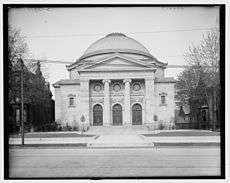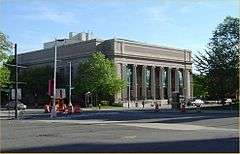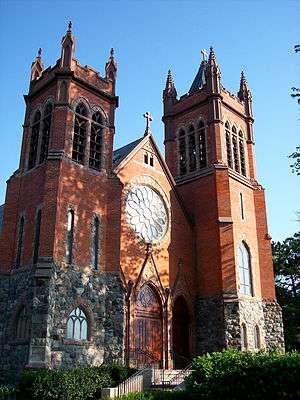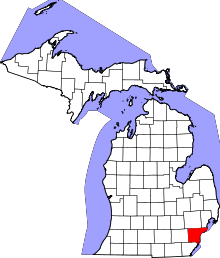Bonstelle Theatre
|
Temple Beth-El | |
 | |
| Location |
3424 Woodward Avenue Detroit, Michigan |
|---|---|
| Coordinates | 42°20′45.92″N 83°3′24.86″W / 42.3460889°N 83.0569056°WCoordinates: 42°20′45.92″N 83°3′24.86″W / 42.3460889°N 83.0569056°W |
| Built | 1902 |
| Architect | Albert Kahn; C. Howard Crane |
| Architectural style | Beaux-Arts |
| Part of | Midtown Woodward Historic District (#08001106) |
| MPS | Religious Structures of Woodward Ave. TR |
| NRHP Reference # | 82002911[1] |
| Significant dates | |
| Added to NRHP | August 3, 1982 |
| Designated CP | November 26, 2008 |
The Bonstelle Theatre is a theater operated by Wayne State University, and located at 3424 Woodward Avenue (the southeast corner of Woodward and Eliot) in the Midtown Woodward Historic District of Detroit, Michigan.[2] It was originally built in 1902 as the Temple Beth-El, and was listed on the National Register of Historic Places in 1982.[1]
Construction
When Rabbi Leo M. Franklin first began leading services at Detroit's Temple Beth El in 1899, he felt that the construction of a new temple building on Detroit's "Piety Row" stretch of Woodward would increase the visibility and prestige of Detroit's Jewish community.[2] Accordingly, in October 1900, the congregation held a special meeting at which it was decided to build a new temple.[3] A site for the new temple was purchased in April of the next year, and Albert Kahn, a member of the congregation, was hired to design the building.[3] Groundbreaking began on November 25, 1901, with the ceremonial cornerstone laid on April 23, 1902.[3] The first services were held in the chapel on January 24, 1903, and the formal dedication was held on September 18–19 of the same year.[3]
Building
The temple is a Beaux-Arts structure influenced primarily by Roman and Greek temples. Sobocinski cites the Pantheon in Rome for comparison. There is a prominent dome over the main area of the temple, with gabled wings on the north and south. A pedimented extension on the front once extended into a porch; the front section of the building was lost when Woodward was widened.[2]
Later use
When the Temple Beth El congregation built another building farther north along Woodward in 1922, they sold the building at Woodward and Eliot to Jessie Bonstelle for $500,000.[4] Bonstelle hired architect C. Howard Crane to convert the building into a theater, naming the resulting building the Bonstelle Playhouse.[4] In 1928, the Bonstelle Playhouse became the Detroit Civic Theatre, and in the 1930s became the Mayfair Motion Picture Theater. In 1951, Wayne State University rented the building as a performance space for its theater company, and purchased it outright in 1956, renaming it the Bonstelle Theatre in honor of Jessie Bonstelle.
Gallery
-

Temple Beth El, c. 1905
-

Jessie Bonstelle in 1908
-
.jpg)
Side view of the theater, with the name still showing on the back house brick
See also
References
- 1 2 National Park Service (2007-01-23). "National Register Information System". National Register of Historic Places. National Park Service.
- 1 2 3 Temple Beth-El from Detroit 1701.org.
- 1 2 3 4 Katz, Irving I., The Beth El Story (with a History of Jews in Michigan Before 1850), Wayne State University Press, 1955, pp. 96-101.
- 1 2 Press release Archived September 1, 2006, at the Wayback Machine. from Wayne State University celebrating the 100th anniversary of the Bostelle Theatre.
Further reading
- Hill, Eric J. and John Gallagher (2002). AIA Detroit: The American Institute of Architects Guide to Detroit Architecture. Wayne State University Press. ISBN 0-8143-3120-3.
- Sobocinski, Melanie Grunow (2005). Detroit and Rome: building on the past. Regents of the University of Michigan. ISBN 0933691092.
External links
- Bonstelle Theatre - Wayne State University
- Photographs from the Rabbi Leo M. Franklin archives: these include photographs c. 1903 - 1922 of both the interior and exterior of the structure.


